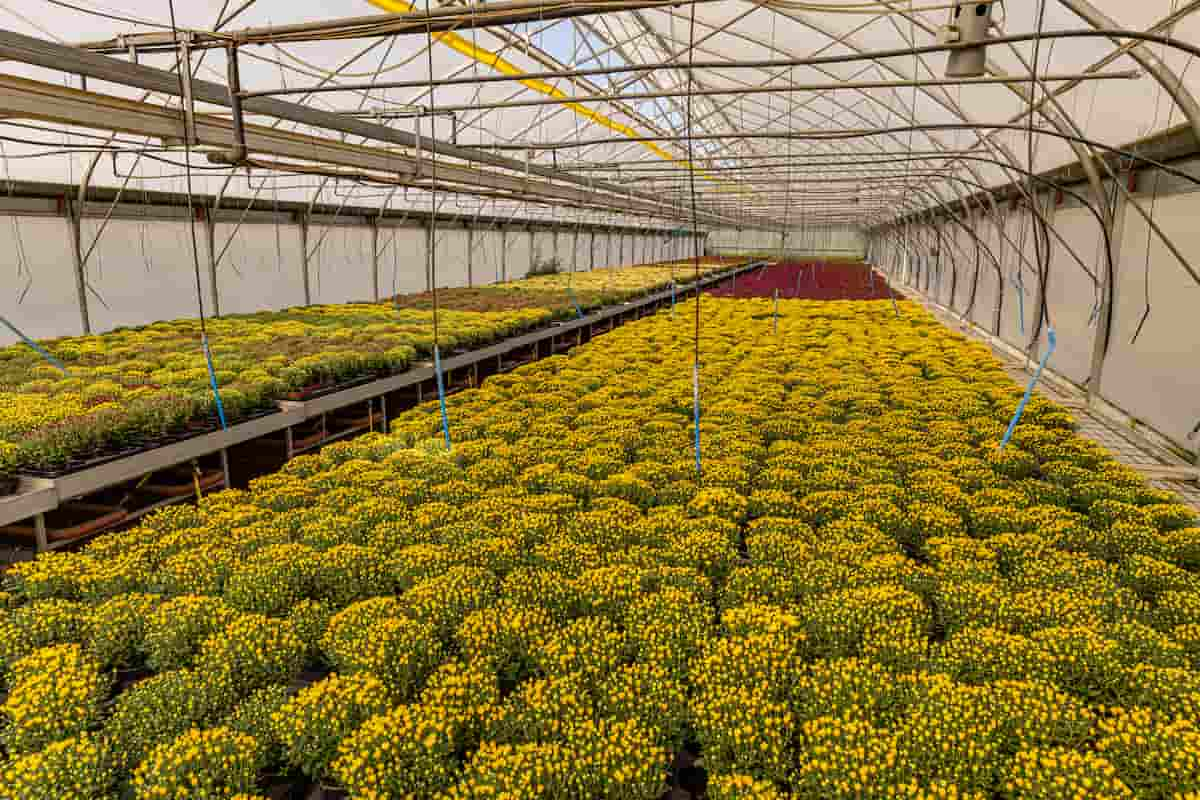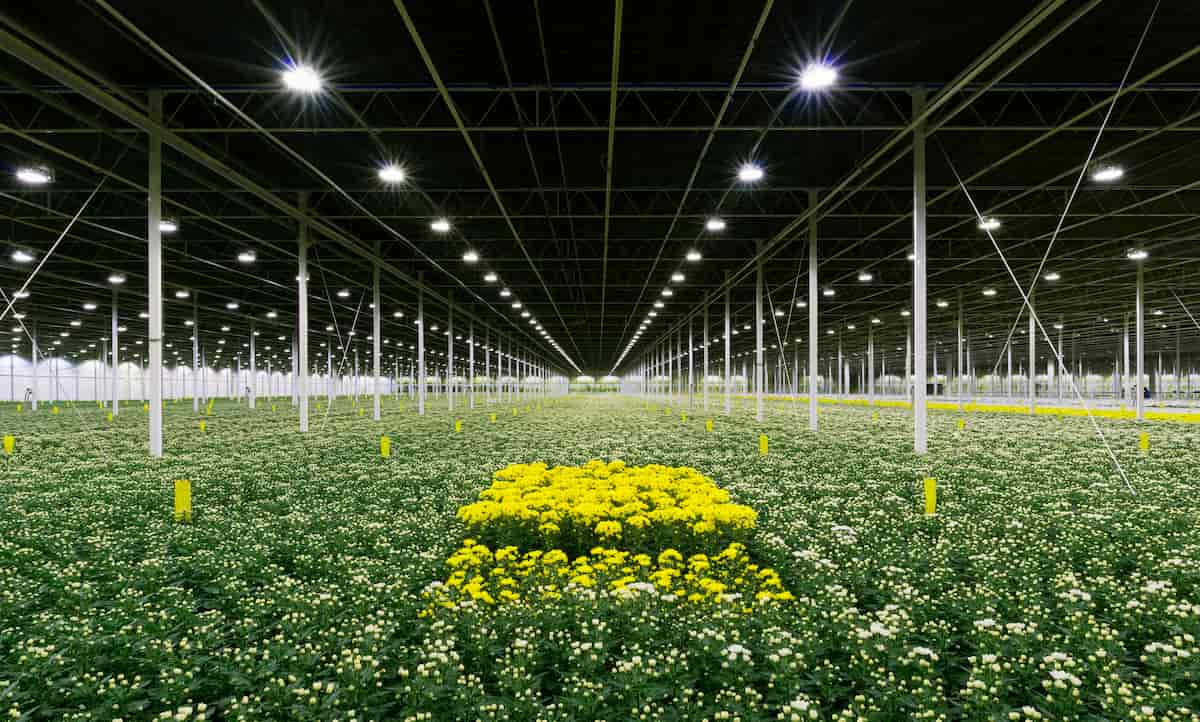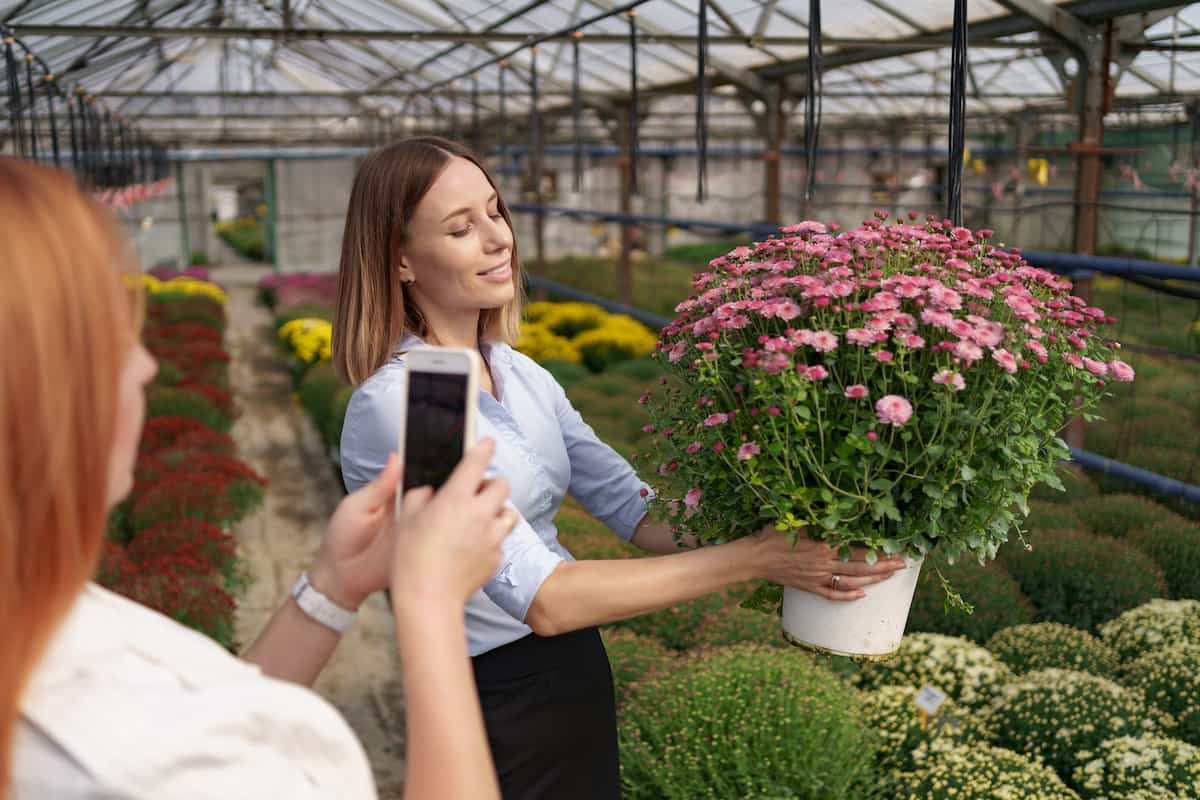If you need chrysanthemums for a special event or your landscape, make your greenhouse work by saving money and buying the species and colors you need. Chrysanthemums come in between 150 and 200 different species. The controlled conditions of a greenhouse are ideal for several types of Chrysanthemums, including Paris daisy and Marguerite. The right growing medium and temperature are essential to the success of greenhouse chrysanthemums.

How to Grow Chrysanthemums in Greenhouse
Types of Chrysanthemum
- Single: Flowers resembling daisies, with long petals radiating from a flat, central “eye”; nearly all varieties are hardy.
- Pompom: Flowers are small, stiff, and almost spherical; some varieties are hardy.
- Cushion: Also known as “azalea” mums, they grow on low, bushy plants and are mostly hardy.
- Anemone: These flowers look like single Chrysanthemums but with a rounded crest of deeper-colored petals; nearly all varieties are hardy.
- Decorative: “incurved” flowers (close, regular petals curving toward the flower center), “incurring” flowers (loose, irregular petals curving toward the flower center), and “reflexed” flowers (all petals curving away from the flower center).
- Spoon: The petals are spoon-shaped; some varieties are hardy.
- Spider: The petals are long and tubular, with hooked ends; few varieties are hardy.
- Quill: The petals are straight, long, and tubular; there are few hardy varieties.
How To Grow Chrysanthemum in Greenhouse
- Before introducing chrysanthemums, the greenhouse should be disinfected, including the floors, walls, and benches. Sterilization eliminates any fungus or bacteria that could spread to the chrysanthemums.
- Plant chrysanthemum cuttings in sterilized, well-draining potting soil. Sterilize the soil by spreading it in a metal baking pan and baking it at 80 to 95°C for 30 minutes. Let the potting soil cool completely before filling peat pots. Sterilizing reduces or eliminates issues with disease and soil-borne insects.
- Plant the cuttings shallowly in the sterilized potting soil, covering the roots. The cuttings should be placed at a 45-degree angle near the rim, allowing light to penetrate the soil and reach the emerging roots. Keep the growing medium moist, not soaking wet.
- Keep the soil moist, especially during rooting, by misting the plants precisely. In the first one to three days after planting, the misting system should be set at a frequency of five to ten minutes. Four to seven days after planting, the mister is adjusted to every 20 minutes, and after eight to 15 days, every 30 minutes. You should ensure the growing medium is constantly moist, not soaking wet, even if you haven’t installed a mister.
- Fertilize the chrysanthemums with approximately six teaspoons of 1-1-1 liquid fertilizer per four liters until they begin to bloom. Reduce the amount of fertilizer applied once flowering occurs until no fertilizer is applied for the last two weeks before cutting.
- The greenhouse’s thermostat should be set between 20 and 24°C during growth or until the plant begins to bloom. As soon as the flowers begin to bud, decrease the night and day temperatures to 18°C. As the last two weeks before harvest, keeping the temperature between 15°C and 18°C is recommended.
- Water the plants once or several times a day, depending on the greenhouse temperature. It is best to water during the early morning or late afternoon hours to evaporate before nightfall.
- Depending on your preference, the chrysanthemums should be harvested when the stems are half or fully open. You should wait until the mums are fully open before displaying them immediately.
Mulching Chrysanthemums Plants Growing in Greenhouse
After planting, spread a layer of mulch over the soil surface. By doing this, you will be able to retain moisture in the soil and prevent weeds from growing. You can use well-rotted manure or garden compost. The roots of plants left in the ground over winter should be insulated with a thick layer of mulch in late autumn.
In case you missed it: How to Grow Cloves in a Greenhouse: A Step-by-Step Guide for Seed to Harvest

Pruning Chrysanthemums Chrysanthemums Plants Growing in Greenhouse
Pinch off the tips when plants are six inches tall to encourage bushiness and blooms. As soon as the plant reaches a foot tall, pinch it back again. Many gardeners pinch back the plants every few weeks until July to promote heavy fall blooming. It is recommended to pinch about 100 days before the desired bloom time. Chrysanthemums planted in spring in greenhouses may have bloomed sooner than they should have.
When you plant it, prune back about a third or half of the stems, and it will likely bloom again in the fall. When Chrysanthemums have bloomed, some gardeners cut them back to about 4 inches tall and cover them with light, airy mulch, straw, or evergreen boughs. The branches help hold mulch in place, so you don’t have to cut them back.
Propagating Chrysanthemums
Plant divisions, cuttings, or seeds can be used to propagate chrysanthemums. Some hybrid chrysanthemums are patented and cannot be propagated without permission. The plant label usually indicates this. Chrysanthemums actually thrive when divided – the new clumps grow better than the old, crowded ones. Dig up the shoots after the last spring frost and carefully pull or cut them apart when they are about 1 to 3 inches tall. Remove any half-dead or overly woody parts and plant only healthy divisions. Phosphorus and organic matter should be added to the planting hole.
Chrysanthemums should be divided and relocated every 3-5 years to prevent disease. You can propagate from cuttings by snipping off a piece about 4-6 inches long and removing the leaves on the bottom half. Insert about 1″ of roots into vermiculite, sand, or sphagnum moss after dipping in the rooting hormone. Make your mini-greenhouse with a wire frame and plastic wrap, and place the plants under bright light (but not sunlight). Seeds should be sown two months before the first frost or started indoors during the winter. It takes 1-3 weeks for seeds to germinate in a planting medium when kept at 21-24°C.
Chrysanthemums Pests
Chrysanthemums are susceptible to a variety of pests. Aphids and leaf miners are the most common pests. Water from a hosepipe can easily be used to remove these pests. The disease spreading can also be stopped by cutting away damaged or affected leaves. Capsid bugs and red spider mites may occasionally attack plants in glasshouses. Taking good growing practices, such as planting correctly, weeding regularly, and not overwatering, will reduce the chance of attack.
Chrysanthemums Diseases
White rust is one of the most damaging plant diseases and is difficult to eradicate. As the disease progresses, pale yellow spots appear on the leaves surface, and the leaves wilt and turn brown. The growth of other leaves and flowers will also be stunted, and bumps may appear on them. Rust diseases can be controlled with chemical fungicides. Organic solutions and good growing practices, such as promptly removing damaged leaves, are equally effective.
Harvesting Greenhouse Grown Chrysanthemums
Harvesting stages vary according to cultivar, marketing, and purpose. Three months after planting, the flowers are harvested every four days for three months. Harvesting usually takes place early in the morning. Approximately 20 cm of stems are collected in trays or buckets containing cold water (15-18°C) and silver nitrate (25 ppm) as a floral preservative. Alternatively, the harvested stems can be placed in 1000ppm silver nitrate for 10-10 seconds.
In case you missed it: How to Grow Lemon Grass in a Greenhouse: A Step-by-Step Guide for Seed to Harvest

Conclusion
Container-grown chrysanthemums can be grown in a variety of greenhouse systems. The production of Chrysanthemums requires well-ventilated greenhouses during the summer months. Consequently, greenhouses must be ventilated properly if outdoor field production is not feasible.
- Ultimate Guide to Ossabaw Island Hog: Breeding, Raising, Diet, and Care
- Ultimate Guide to Juliana Pig: Raising Facts, Size, Diet, Care, and Lifespan
- Raising Lleyn Sheep: Disadvantages, Price, Uses, Characteristics, and Care
- Ultimate Guide to Meishan Pig: Breed Facts, Breeding, Raising, and Care
- Ultimate Guide to Teacup Pigs: Raising, Diet, Lifespan, Cost, and Care
- Guide to Raising Poll Dorset Sheep: Facts, Profile, Characteristics, Uses, and Care
- Ultimate Guide to Bighorn Sheep: Characteristics, Diet, Lifespan, Breeding, and Lifecycle
- Ultimate Guide to Raising Katahdin Sheep: Farming Facts, Breed Profile, Uses, and Care
- Ultimate Guide to Raising Oreo Cows: Belted Galloways Farming Facts, Profile, Uses, and Care